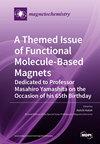非等效反铁磁耦合子晶格诱发两步自旋交叉转换:平衡与非平衡方面
IF 2.6
4区 化学
Q2 CHEMISTRY, INORGANIC & NUCLEAR
引用次数: 0
摘要
作为之前发表的研究成果(Yalçın 等人(2022 年))的延续,我们研究了自旋交叉系统的平衡和非平衡特性,特别关注非等效子晶格,并将这些特性与等效子晶格的特性进行了比较。我们使用最低近似簇变化法(LACVM)推导出了两个子晶格的阶次参数静态方程,并确定了自旋交叉体系中高自旋分数与温度和外磁场的关系。在低温下,nHS=1 的稳定高自旋(HS)态过渡发生在高原区,nHS=0.5 的非等价子晶格过渡发生在高原区。非等价子晶格的阶参数在过渡温度下表现出不同的状态。此外,我们还利用路径概率法(PPM)研究了阶次参数和高自旋分数的非平衡特性。利用当前模型,我们获得并分析了阶次参数 Sa、Sb 和高自旋分数的弛豫曲线。这些曲线证明了低温下双稳态的存在。在本研究的最后,我们展示了不同温度值下的阶次参数流程图。该图显示了稳定、易陨和不稳定的状态。本文章由计算机程序翻译,如有差异,请以英文原文为准。
Nonequivalent Antiferromagnetically Coupled Sublattices Induce Two-Step Spin-Crossover Transitions: Equilibrium and Nonequilibrium Aspects
As a continuation to the previously published work (Yalçın et al. (2022)), we investigate the equilibrium and nonequilibrium properties of the spin-crossover systems, with a specific focus on the nonequivalent sublattice, and compare these properties with those of the equivalent sublattices. We used the lowest approximation of the cluster variation method (LACVM) to derive the static equations for the order parameters of the two sublattices and determine high-spin fraction in relation to temperature and external magnetic field in a spin-crossover system. At a low temperature, the transition from stable high-spin (HS) state where nHS=1 occurs in the plateau region, where nHS=0.5 for nonequivalent sublattices. The order parameters for non-equivalent sublattices exhibit different states at the transition temperature. Also, we study the nonequilibrium properties of the order parameters and high-spin fraction using the path probability method (PPM). With the current model, we obtain and analyze the relaxation curves for the order parameters Sa, Sb, and high-spin fraction. These curves demonstrate the existence of bistability at low temperatures. At the end of this study, we present the flow diagram that shows the order parameters for different temperature values. The diagram exhibits states that are stable, metastable, and unstable.
求助全文
通过发布文献求助,成功后即可免费获取论文全文。
去求助
来源期刊

Magnetochemistry
Chemistry-Chemistry (miscellaneous)
CiteScore
3.90
自引率
11.10%
发文量
145
审稿时长
11 weeks
期刊介绍:
Magnetochemistry (ISSN 2312-7481) is a unique international, scientific open access journal on molecular magnetism, the relationship between chemical structure and magnetism and magnetic materials. Magnetochemistry publishes research articles, short communications and reviews. Our aim is to encourage scientists to publish their experimental and theoretical results in as much detail as possible. Therefore, there is no restriction on the length of the papers. The full experimental details must be provided so that the results can be reproduced.
 求助内容:
求助内容: 应助结果提醒方式:
应助结果提醒方式:


